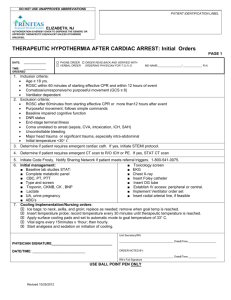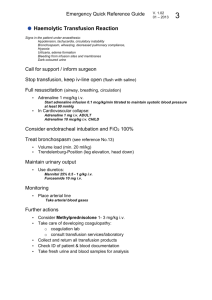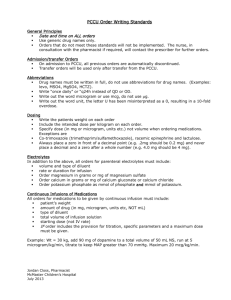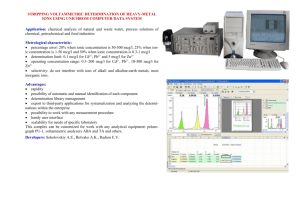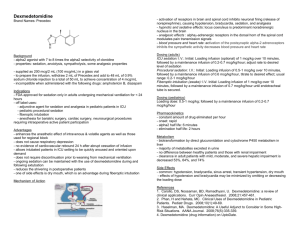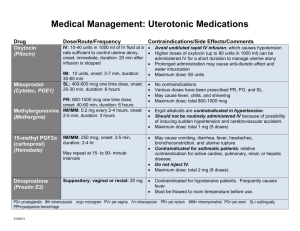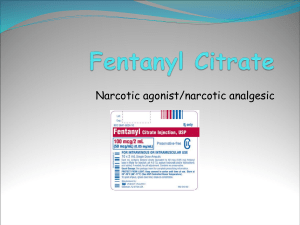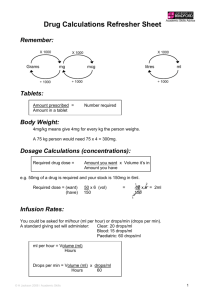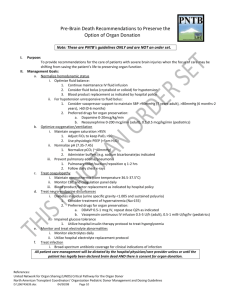Intravenous medications in the Emergency Department
advertisement
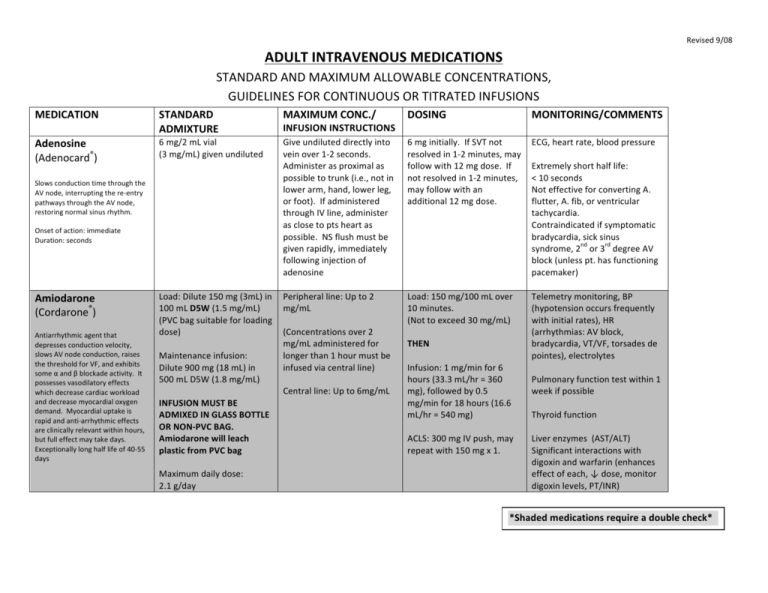
Revised 9/08 ADULT INTRAVENOUS MEDICATIONS STANDARD AND MAXIMUM ALLOWABLE CONCENTRATIONS, GUIDELINES FOR CONTINUOUS OR TITRATED INFUSIONS MEDICATION STANDARD ADMIXTURE MAXIMUM CONC./ DOSING MONITORING/COMMENTS Adenosine (Adenocard®) 6 mg/2 mL vial (3 mg/mL) given undiluted Give undiluted directly into vein over 1-­‐2 seconds. Administer as proximal as possible to trunk (i.e., not in lower arm, hand, lower leg, or foot). If administered through IV line, administer as close to pts heart as possible. NS flush must be given rapidly, immediately following injection of adenosine 6 mg initially. If SVT not resolved in 1-­‐2 minutes, may follow with 12 mg dose. If not resolved in 1-­‐2 minutes, may follow with an additional 12 mg dose. Amiodarone (Cordarone®) Load: Dilute 150 mg (3mL) in 100 mL D5W (1.5 mg/mL) (PVC bag suitable for loading dose) Maintenance infusion: Dilute 900 mg (18 mL) in 500 mL D5W (1.8 mg/mL) INFUSION MUST BE ADMIXED IN GLASS BOTTLE OR NON-­‐PVC BAG. Amiodarone will leach plastic from PVC bag Maximum daily dose: 2.1 g/day Peripheral line: Up to 2 mg/mL (Concentrations over 2 mg/mL administered for longer than 1 hour must be infused via central line) Central line: Up to 6mg/mL Load: 150 mg/100 mL over 10 minutes. (Not to exceed 30 mg/mL) THEN Infusion: 1 mg/min for 6 hours (33.3 mL/hr = 360 mg), followed by 0.5 mg/min for 18 hours (16.6 mL/hr = 540 mg) ACLS: 300 mg IV push, may repeat with 150 mg x 1. ECG, heart rate, blood pressure Extremely short half life: < 10 seconds Not effective for converting A. flutter, A. fib, or ventricular tachycardia. Contraindicated if symptomatic bradycardia, sick sinus nd rd syndrome, 2 or 3 degree AV block (unless pt. has functioning pacemaker) Telemetry monitoring, BP (hypotension occurs frequently with initial rates), HR (arrhythmias: AV block, bradycardia, VT/VF, torsades de pointes), electrolytes Pulmonary function test within 1 week if possible Thyroid function Liver enzymes (AST/ALT) Significant interactions with digoxin and warfarin (enhances effect of each, ↓ dose, monitor digoxin levels, PT/INR) Slows conduction time through the AV node, interrupting the re-­‐entry pathways through the AV node, restoring normal sinus rhythm. Onset of action: immediate Duration: seconds Antiarrhythmic agent that depresses conduction velocity, slows AV node conduction, raises the threshold for VF, and exhibits some α and β blockade activity. It possesses vasodilatory effects which decrease cardiac workload and decrease myocardial oxygen demand. Myocardial uptake is rapid and anti-­‐arrhythmic effects are clinically relevant within hours, but full effect may take days. Exceptionally long half life of 40-­‐55 days INFUSION INSTRUCTIONS *Shaded medications require a double check* MEDICATION STANDARD ADMIXTURE MAXIMUM CONC./ DOSING MONITORING/COMMENTS Atropine 1 mg/10 mL Abboject syringe (0.1 mg/mL) May be administered without further dilution Asystole/PEA: No longer recommended per 2010 ACLS guidelines Bradycardia: 0.5 mg IV Vital signs and/or EKG Doses < 0.5 mg may lead to paradoxical bradycardia Bumetanide (Bumex ) 0.25 mg/mL (2 mL, 4 mL, 10 mL) Infusion: 12 mg/48 mL (0.25 mg/mL) PROTECT FROM LIGHT Non-­‐formulary at HH 1 g/10 mL Abboject syringe May be given undiluted. Not usually added to IV solutions but compatible with D5W, NS, and LR IV push: 0.5-­‐1 mg/dose May repeat in 2-­‐3 hours Infusion: 0.25-­‐2 mg/hr DO NOT EXCEED 10 MG/24 HOURS 1 mg Bumex = 40 mg Lasix 8-­‐16 mg/kg IV at 100 mg/min (Typical dose = 1g) May repeat as necessary at 10 minute intervals HR, BP, electrolytes, UOP, CO2, BUN, glucose Routine BMP and uric acid checks necessary during treatment Blocks the action of acetylcholine at parasympathetic sites in smooth muscle, secretory glands, and the CNS; increases cardiac output Onset of action: very rapid Duration: 2-­‐3 hours ® Potent loop diuretic. Works in the ascending Loop of Henle and proximal renal tubule to excrete + + -­‐ H2O, Na , K , Cl Onset of action: 2-­‐3 minutes Duration: 4-­‐6 hours Calcium Chloride Electrolyte INFUSION INSTRUCTIONS May be administered without further dilution Vital signs Central line recommended Calcium chloride not recommended for uses other than cardiac resuscitation or management of calcium channel blocker toxicity. Contains three times more elemental calcium than calcium gluconate. MEDICATION STANDARD ADMIXTURE MAXIMUM CONC./ INFUSION INSTRUCTIONS DOSING MONITORING/COMMENTS Calcium Gluconate 1 g/10 mL (10%) May be administered without further dilution or may be further diluted in up to 1,000 mL of NS Emergency elevation of serum calcium: 15-­‐30 mL (7-­‐14 mEq). Repeat in 1-­‐3 days per pt. response Hyperkalemia: 4.1-­‐30 mL (2.25 -­‐ 14 mEq). May repeat in 1-­‐2 minutes if indicated as per EKG. Do not exceed 2mL/min Bolus: 0.25 mg/kg IV (typical dose = 20 mg) May repeat with 0.35 mg/kg if no response after 15 min. (typical repeat dose (25 mg) Infusion: 5 – 15 mg/hr (5 -­‐15 mL/hr). Initiate at 5 mg/hr. Max dose: 15 mg/hr May only use for 24 hours Infusion: 2 – 20 mcg/kg/min Gradually adjust rate at 2 to 10 minute intervals. AHA guidelines recommend titrating so that HR does not increase by > 10% from baseline. If rates > 20 – 30 mcg/kg/min required, should consider alternate inotropic agent Vital signs, EKG Rapid administration may cause vasodilation, ↓BP, arrhythmias, syncope, or cardiac arrest. Electrolyte Diltiazem (Cardizem®) Non-­‐dihydropyridine calcium 2+ channel blocker that blocks Ca ion influx during depolarization of cardiac and vascular smooth muscle. It decreases SVR and causes relaxation of the vascular smooth muscle resulting in ↓BP. Slows conduction through the AV node, prolongs the refractory period, and reduces ventricular rate. Decreases HR by 10% with a single dose. Bolus: 5 mg/mL vial Bolus: No dilution required May be given undiluted through Y-­‐tube or 3-­‐way Infusion: 1 mg/mL stopcock of tubing containing NS, D5W, or D5 ½ NS Infusion: Add 125 mg (25mL) to 100mL D5W or NS (1 mg/mL) Infusion: 500 mg/250 mL D5W premixed bag (2,000 mcg/mL) Synthetic sympathomimetic catecholamine that stimulates the β [concentrated 1000 mg/250 mL available if necessary receptors of the heart. Positive inotrope (↑ CO, ↑contractility, (4,000 mcg/mL)] ↑CI). Produces minimal increases in rate and BP. Provides the extra Vial: 250 mg/20 mL “squeeze” in patients with cardiac (12.5 mg/mL) decompensation. Dobutamine (Dobutrex®) Onset of action: 1-­‐10 minutes MAX: 5 mg/mL (1,250 mg/250 mL) in D5W or NS Preferably given via central line ↓HR, arrhythmias ↓BP, flushing, edema EKG monitoring during infusion preferred Stored in refrigerator ↑HR, ↑BP or ↓BP (typically associated with overdose) Arrhythmia, myocardial ischemia, ↑CO Decreased effect seen in profoundly acidotic patients. MEDICATION STANDARD ADMIXTURE DOSING MONITORING/COMMENTS Dopamine (Inotropin®) MAXIMUM CONC./ INFUSION INSTRUCTIONS Infusion: 400 mg/250 mL D5W premixed bag (1,600 mcg/mL) Vial: 200 mg/5 mL MAX: 6.4 mg/mL (1,600 mg/250 mL) Preferably given via central line Infusion: 2.5 – 20 mcg/kg/min If more than 20 mcg/kg/min is required to maintain BP, consider use of norepinephrine in addition Epinephrine (Adrenalin®) 1 mg/10 mL (1:10,000) Abboject syringe 1 mg/1 mL (1:1000) vial Infusion: 1 mg/250 mL NS (4 mcg/mL) [concentrated 2 mg/250 mL or 4 mg/250 mL available if necessary) 10 mg/250 mL NS (cardiac arrest infusion) 4 mg/ 250 mL NS or D5W (16 mcg/mL) Some institutions report higher concentrations, if needed (Duke = 10mg/250 mL) (Lit = 30 mg/250 mL) ACLS Bolus: 1 mg/10 mL (1:10,000 syringe) q3-­‐5 min [1mg/ mL (1:1,000) must be diluted in 10 mL NS before IV administration] ACLS infusion: *30mg/250 mL at 100 mL/hour then titrate *10mg/250 mL at .01-­‐1.2 mcg/kg/min Vasopressor or maintenance infusion: 1 – 10 mcg/min Rates > 10 mcg/min, should consider alternate or additional vasopressor ↑BP, palpitations, arrhythmias, ↑HR, peripheral necrosis with ↑doses Infuse via central line to avoid extravasation Fluid resuscitate pts. prior to vasopressor therapy. Effect diminished in acidosis. Do not administer through same line as sodium bicarbonate! ↑HR, ↑BP (monitor BP and HR q5min) Arrhythmias, tremor, anxiety, pulmonary edema, myocardial ischemia Monitor for signs of peripheral necrosis Catecholamine precursor to norepinephrine that activates α, β, and DA receptors. 5-­‐10 mcg/kg/min: renal, mesenteric, coronary dilation 10-­‐20 mcg/kg/min: increased contractility, HR >20 mcg/kg/min : vasoconstriction, increased HR and BP Onset of action: 5 minutes Natural symmpathomimetic catecholamine, both an α and β agonist. Can ↑SVR, ↑BP (via vasoconstriction). It is a potent cardiac stimulant (↑HR, ↑contraction) and dilates bronchi *Shaded medications require a double check* MEDICATION STANDARD ADMIXTURE Eptifibatide (Integrilin®) 200 mg/100 mL vial (2,000 mcg/mL) Blocks platelet glycoprotein IIb/IIIa receptor, the binding site for fibrinogen, von Willebrand factor, and other ligands. Reversibly blocks platelet aggregation and prevents thrombosis Bolus: Dose administered from 100mL vial, given undiluted over 1-­‐2 minutes ***Give with heparin or lovenox*** MAXIMUM CONC./ INFUSION INSTRUCTIONS DOSING MONITORING/COMMENTS Bolus: Over 1-­‐2 minutes Infusion: Administered directly from vial Max bolus dose = 22.6 mg Max infusion rate = 15 mg/hr ACS Bolus: 180 mcg/kg administered over 1-­‐2 minutes Infusion: 2 mcg/kg/min (max of 15 mg/hr) Renal Dysfunction: If CrCl < 50 mL/min, ↓ infusion to 1 mcg/kg/min. Platelets, Hgb, SCr, PT/aPTT Signs of bleeding – avoid BP cuffs, watch IV sites, monitor for black tarry stools etc. Modified Cockroft-­‐Gault equation to determine CrCl: (140 – age/SCr) [x 0.85 if female] (this equation provides a rough estimation of CrCl in order to determine an approximation of the patients renal function) ↓HR, ↓BP, arrhythmias, CHF, bronchospasm, thrombophlebitis Should taper off slowly Infuse via central line to prevent extravasation Esmolol (Brevibloc®) Bolus: May be given undiluted ***Only use 10 mg/mL amp*** Infusion: 2,500 mg/250 mL NS premixed bag (10 mg/mL) 20 mg/mL (5,000 mg/250 mL) D5W or NS Etomidate (Amidate®) 2 mg/mL vial May be given undiluted Dose may be given undiluted, administered over 30 – 60 seconds Short acting β1 selective adrenergic blocker (may have some β2 activity at high doses). Has antiarrhythmic properties and acts to ↓HR, ↓BP, and ↓ contractility in a dose-­‐ related manner. Used for Tx of SVT with RVR or HTN Onset of action: 2-­‐10 minutes. Duration is 10-­‐30 minutes. Short-­‐acting, non-­‐barbiturate hypnotic without analgesic activity. Able to produce the full spectrum of CNS depression, from light sleep to coma. Onset of action: 60 seconds Duration: ~ 5 minutes. SVT Bolus: 500 mcg/kg over 1 minute Infusion: Start infusion at 50 mcg/kg/minute. Titrate to response q4min up to a maximum dose of 200 mcg/kg/min HTN control = up to 300 mcg/kg/min 0.3 mg/kg Pain with infusion common Myoclonus commonly seen May increase EEG activity in focal seizures Will cause transient adrenal suppression, use caution in septic patients. *Shaded medications require a double check* MEDICATION Fentanyl (Sublimaze®) Opium derived narcotic analgesic which is a descending CNS depressant. Approximately 100 times more potent than morphine mg for mg. Has definite respiratory depressant actions that outlast its analgesic effects. Onset of action: almost immediate Duration: 0.5-­‐1 hour. Furosemide (Lasix®) Potent loop diuretic. Works in the + loop of Henle to excrete H20, Na , + -­‐ K , Cl Onset of action: ~ 5 minutes Duration: 2 hours Heparin Potentiates the action of antithrombin III, thereby inactivating thrombin (as well as factors IX, X, XI, XII, and plasmin). Prevents conversion of fibrinogen to fibrin Onset of action: almost immediate STANDARD ADMIXTURE MAXIMUM CONC./ INFUSION INSTRUCTIONS DOSING MONITORING/COMMENTS Bolus: Small volumes may be given undiluted (50 mcg/mL) Infusion: 1,250 mcg/250 mL (5 mcg/mL) PCA: 1,250 mcg/25 mL (50 mcg/mL) See Standard PCA Order Form Epidural: 2 or 5 mcg/mL with bupivicaine 0.125% in 250 mL NS 50 mcg/mL undiluted drug Other bupivicaine concentrations available per request (e.g., 0.0625%) Titrate to effect using pain scale or RASS score Infusion: 25 – 100 mcg/hr Bolus: 10 mg/mL undiluted drug Infusion: 100 mg/100 mL NS (1 mg/mL) Protect from light Bolus: 10 mg/mL May be further diluted upon request Infusion: 100 mg/mL (1 mg/mL) D5W or NS (infusion bag stable for 24 hours) Preprinted weight-­‐based forms available Titrate to desired effect Infusion rate should not exceed 4 mg/min A 1 gram dose should infuse over at least 3 hours to prevent ototoxicity ↓RR, ↓HR, ↓BP Pain scale assessment for analgesia RASS score for sedation Naloxone (Narcan) is antidote Use caution in obese patients. Fentanyl distributes to adipose tissue, requiring a larger initial dose to see effect. Duration of effect will be greatly extended as drug is slowly released from adipose tissue. Monitor respiratory status closely. HR, BP, electrolytes, UOP Over-­‐diuresis may precipitate a contraction alkalosis Infusion: 25,000 units/500 mL D5W (50 units/mL) See preprinted weight based Platelets, Hgb, aPTT protocols Signs of bleeding – watch IV sites, monitor for black tarry stools, etc Antidote: Protamine – each 1mg will reverse 100 units of heparin. *Shaded medications require a double check* MEDICATION STANDARD ADMIXTURE MAXIMUM CONC./ INFUSION INSTRUCTIONS DOSING MONITORING/COMMENTS Insulin, Regular (Novolin R®) Vial: 100 units/mL Infusion: 100 units/100 mL NS (1 unit/mL) 1 unit/mL Usually diluted in NS or ½NS. Also compatible with D5W May adhere to IV tubing Infusion: Titrate to desired blood glucose goals – follow protocol If pt in DKA, please titrate IVF’s, not insulin drip Hypoglycemia (FSBS) ONLY Regular insulin may be given IV Do not lower BG by >100 mg/dL per hour. Rapid lowering may lead to cerebral edema 20 mcg/mL D5W or NS Infusion: 2-­‐20 mcg/min (Up to 30 mcg/min in severe shock) ↑HR, arrhythmias, ↑or↓BP, flushing, HA, pulmonary edema IV Bolus: 20 mg over at least 2 minutes Max concentration: 5 mg/mL Bolus: 20 mg as initial dose, may repeat with doses of 40-­‐80 mg q10min Do not exceed total dose of 300 mg Infusion: starting 2 mg/min (2 mL/min) – 8 mg/min titrated to response. Do not exceed total dose of 300 mg. BP – before & 5-­‐10 minutes after injection or during infusion. Keep patient supine and assist with ambulation (postural hypotension) As cumulative dose nears 300mg IV, duration of action extends to nearly 18 hours. Pancreatic hormone responsible for storage, metabolism, and uptake of carbohydrates, fats, and protein. Facilitates entry of glucose into muscle, adipose and other tissues. Onset of action: 30 minutes Isoproterenol (Isuprel®) 1 mg/250 mL D5W (4 mcg/mL) Synthetic sympathomimetic that stimulates β1 and β2 receptors resulting in relaxation of bronchial, GI, and uterine smooth muscle, increased heart rate and contractility, and vasodilation of peripheral vasculature Onset of action: immediate Duration: 10-­‐15 minutes Labetalol (Trandate®) Blocks α, β1, and β2 adrenergic receptor sites. Decreases heart rate and peripheral vascular resistance. Ratio of alpha-­‐ to beta-­‐ blockade depends upon the route of administration (1:3 oral versus 1:7 IV) Onset of action: 2-­‐5 minutes Duration: 2-­‐4 hours Bolus: 5 mg/mL undiluted Infusion: 200 mg/200 mL (Add 200mg [40 mL] labetalol to 160 mL D5W, NS, LR, or D5/NS) Final concentration: 1 mg/mL *Shaded medications require a double check* MEDICATION STANDARD ADMIXTURE MAXIMUM CONC./ INFUSION INSTRUCTIONS DOSING MONITORING/COMMENTS Lidocaine Bolus: 100 mg/5 mL Abboject syringe (2%) Infusion: 2,000 mg/500 mL D5W (4 mg/mL) premade bag (Concentrated 4,000 mg/500 mL available if necessary) 8 mg/mL in D5W Monitor EKG continuously Monitor HR, BP, CNS effects (confusion, nervousness, seizure), cardiovascular collapse, arrhythmias Lidocaine levels (if maintained on lidocaine drip, would draw level 12 hours after initiating drip then q24h thereafter) ACLS note: If pt. has received amiodarone, there is no evidence supporting the use of concurrent lidocaine. Once an antiarrhythmic agent has been chosen per the ACLS algorithm, need to stay with that agent. Magnesium 1 gm/50 mL D5W 2 gm / 100 mL D5W 4 gm/100 mL D5W 1 gm / hr Midazolam (Versed®) 100 mg/mL NS pre-­‐made bag (1 mg/mL) 1 mg/mL Bolus: 1-­‐1.5 mg/kg (avg. 50-­‐100 mg) Infuse over 2-­‐3 minutes. May repeat bolus dose in 3-­‐5 minutes to a max of 3 doses Infusion: With return of perfusion, initiate at 1-­‐4 mg/min. Do not exceed 4 mg/min. Decrease dose by 50% for CHF, impaired liver function, elderly, use of drugs that may decrease hepatic clearance of lidocaine (e.g., beta blockers), shock Case based (suggested doses): 1.5 -­‐ 2.0: give 2 g TRO 2 hrs 1.0 -­‐ 1.5: give 4 g TRO 4 hrs < 1.0: give 8 g TRO 8 hrs Titrate to effect using RASS RSI induction: 0.2-­‐0.3 mg/kg Infusion: Initially 1-­‐7 mg/hr, then titrate according to RASS Use lower initial dose if receiving concurrent sedatives/analgesics Local anesthetic and class Ib antiarrhythmic. Suppresses automaticity of conduction tissue by increasing the electrical stimulation threshold of the ventricle. With usual therapeutic doses does not change myocardial contractility, systemic arterial pressure, or absolute refractory period. Onset of action: 2 minutes Duration: 10-­‐20 minutes (half life increases with repeat dosing) Electrolyte Short acting benzodiazepine with sedative, anxiolytic, and amnestic properties. Three to four times as potent as diazepam. Onset of action: 1-­‐5 minutes Duration: average 2 hours ↓BP Mg levels ↓RR, ↓BP, ↓HR Drowsiness, impaired memory or coordination, agitation (paradoxical) Flumazenil (Romazicon) is antidote but its use is strongly discouraged, especially if pt. has a h/o benzo use or Sz history. May precipitate seizures via irreversible binding of BZD receptors (GABA) – Duration~1hr *Shaded medications require a double check* MEDICATION STANDARD ADMIXTURE MAXIMUM CONC./ INFUSION INSTRUCTIONS DOSING MONITORING/COMMENTS Morphine Bolus: may be given undiluted Usually 1 mg/mL Infusion: 100 mg/mL in D5W (1 mg/mL) PCA: 30 mg/30 mL (1 mg/mL) See standard PCA order form Bolus: average 2.5 – 15 mg. Repeat q2-­‐4h as needed Recommend lower initial dose for renal or hepatic dysfunction and in elderly. Infusion: Titrate to effect using pain scale or RASS Narcotic overdose: 0.4 – 2 mg. May repeat in 2-­‐3 minutes if indicated. Typically start with lower dose then increase as needed. (May initiate with 0.1 mg in patients with known opioid dependence to prevent withdrawal reaction) Opioid induced pruritis: 0.25 mcg/kg/min. Monitor pain control to ensure naloxone is not reversing analgesia Bolus: 2 mcg/kg over 1 minute (withdraw bolus from the prepared infusion bag) Infusion: 0.01 mcg/kg/min ↓BP, ↓RR, HR, GI effects (constipation) Pain scale assessment for analgesia. Active metabolite Morphine-­‐6-­‐Glucuronide accumulates in renal dysfunction. Naloxone (Narcan) is antidote Opium-­‐derived narcotic analgesic, CNS depressant, respiratory depressant. Relieves pulmonary congestion, reduces myocardial oxygen demand, and reduces anxiety. Onset of action: Almost immediate Duration: Average of 2 hours May be given undiluted, 1 mg/mL diluted with SW for injection, or further diluted in NS or Pure opioid antagonist that competes and displaces narcotics at D5W and given as an infusion. opioid receptors. Infusion: 2 mg/500 mL NS or Onset of action: ~ 2 minutes D5W (0.004 mcg/mL [4 Duration: 30-­‐45 minutes (up to 2 mcg/mL]) hours if given IM) Naloxone (Narcan®) Nesiritide (Natrecor®) Recombinant human BNP, dilates veins & arteries. Produces dose dependent decrease in PCWP & systemic arterial pressure. Used for treatment of acutely decompensated CHF in pts with dyspnea at rest or with minimal activity Onset of action: 15 minutes Duration: >60 minutes (up to several hours) 1.5 mg in 250 mL D5W or NS (6 mcg/mL) [reconstitute vial with 5 mL gently rolling vial in hand to dilute. DO NOT SHAKE] 6 mcg/mL RR, HR, BP, temp, level of consciousness, O2 sat Monitor for withdrawal symptoms Ineffective against respiratory depression caused by barbiturates, anesthetics, other non-­‐narcotic agents, or pathological conditions BP (may last for hours) UOP, renal function Continuous tele monitoring PCWP MEDICATION Nicardipine (Cardene®) Dihydropyridine calcium channel blocker. Causes coronary and peripheral blood vessel dilation leading to ↓SVR, ↑ CO, ↑ coronary blood flow, and myocardial oxygen supply without increasing cardiac oxygen demand. Onset of action: 10 minutes Duration: <8 hours STANDARD ADMIXTURE MAXIMUM CONC./ INFUSION INSTRUCTIONS 25 mg/250 mL D5W or NS 0.1 mg/mL (0.1 mg/mL) (withdraw 10 mL from 250 mL If infused peripherally, bag prior to addition of change IV site Q12h nicardipine for 0.1mg/mL final concentration) DOSING MONITORING/COMMENTS Infusion: 5 mg/hr (50 mL/hr) Increase rate by 2.5 mg/hr every 5-­‐15 minutes up to max of 15 mg/hr Consider reducing to 3 mg/hr for maintenance BP, HR HA, nausea/vomiting USE EXTREME CAUTION IN PTS WITH RIGHT VENTRICULAR INFARCT (these pts are extremely sensitive to effects of nitroglycerine. Use may cause a precipitous drop in BP) Monitor: BP, HR, HA Flushing, postural hypotension, reflex tachycardia, dizziness Methemoglobinemia Antidote: Decrease rate, elevate foot of bed, IV fluids, oxygen, epinephrine HR, ↓BP, flushing, HA Renal function Hepatic Function Cyanide, thiocyanate, or methemoglobin levels for prolonged use or suspected toxicity. Do not use in renal failure – Risk of cyanide toxicity DO NOT USE IN NEUROLOGIC INJURY (trauma, stroke, etc.). Will lead to ↑CBF, causing ↑ICP which may lead to secondary infarct Nitroglycerin 50 mg/250 mL D5W (200 mcg/mL) Pre-­‐mixed in glass bottle Start with 5 mcg/min then increase by 5 mcg/min Q3-­‐ 5min until desired response obtained. If not response at 20 mcg/min, may increase by 10 mcg/min. No fixed maximum dose Tolerance may develop after 12-­‐24 hours, requiring nitrate free period Unstable angina or CHF associated with MI: 10-­‐20 mcg/min and increase by 10-­‐20 mcg/min until desired effect. May need bolus of 12.5 to 25 mcg. Need nitro free period for effect to last Nitroprusside (Nitropress®) 50 mg/250 mL D5W (200 mcg/mL) PROTECT FROM LIGHT Solution will have a faint brownish tint. Discard solution if highly colored, blue, green, or dark red 100 mg/250 mL D5W (400 mcg/mL) Infusion: 0.1 – 5 mcg/kg/min AHA recommends starting with 0.1 mcg/kg/min, then gradually titrating every 2-­‐ 3 minutes. Small adjustments can lead to major fluctuations in BP. Doses > 3 mcg/kg/min rarely needed. Do not exceed 10 mcg/kg/min Causes relaxation of smooth muscle, producing a vasodilator effect on the peripheral veins and arteries with more prominent effects on the veins. Primarily reduces cardiac oxygen demand by decreasing preload. May modestly reduce afterload. Dilates coronary arteries and improves collateral flow to ischemic regions Onset of action: Immediate Duration: 3-­‐5 minutes Potent, rapid acting antihypertensive. Causes peripheral vasodilation by direct action on venous and arteriolar smooth muscle, thus reducing peripheral resistance. Decreases BP and SVR, but will ↑CO and may ↑HR. Metabolized in RBCs to cyanide, then in the liver to thiocyanate. Liver or kidney dysfunction can affect metabolism and elimination. Onset of action: < 2 min Duration: 1-­‐10 minutes *Shaded medications require a double check* MEDICATION STANDARD ADMIXTURE MAXIMUM CONC./ INFUSION INSTRUCTIONS DOSING MONITORING/COMMENTS Norepinephrine (Levophed®) 4 mg/250 mL D5W (16 mcg/mL) NS alone not recommended due to loss of potency from oxidation 8 – 16 mg/250 mL D5W (32 – 64 mcg/mL) Infuse via central line to avoid extravasation 0.5 – 30 mcg/min Initiate at lower doses, then titrate to effect Rates > 30 mcg/min, should consider additional or alternative vasopressor ↑HR, arrhythmias, ↑BP, HA, ↑SVR, ↑PCWP, ↓renal blood flow Acidosis will greatly diminish effect. Octreotide (Sandostatin®) Bolus: 50 mcg/mL May be given undiluted Infusion: 500 mcg/100 mL NS (5 mcg/mL) 10 mcg/mL in NS or D5W bag or glass Glucose, GI effects, HA, LFTs Pancuronium (Pavulon®) Bolus 1 mg/mL May be given undiluted Infusion: 100 mg/100 mL undiluted (1 mg/mL) 1 mg/mL In manufacturer’s diluents Bolus: 50-­‐100 mcg over 3 minutes (undiluted) Antidiarrheal (AIDS): initial 100 mcg, followed by infusion of 10-­‐100 mcg/hr GI Bleed: Loading dose of 50-­‐100 mcg followed with a continuous infusion of 25-­‐50 mcg/hr for 72 to 96 hours Bolus: 0.04 – 0.1 mg/kg over 1 minute Infusion: 0.06 – 0.1 mg/kg/hr (1 -­‐ 1.7 mcg/kg/min) Titrate to effect Natural sympathomimetic catecholamine, α1, and β1 agonist. Causes peripheral vasoconstriction, stimulates cardiac contractility and dilates coronary arteries. ↑HR and↑SVR. Onset of action: very rapid Duration: 1-­‐2 minutes Somatostatin analog, suppresses serotonin secretion, growth hormone, and other gastro-­‐ pancreatic peptides (insulin, gastrin, glucagon, etc.). Stimulates fluid and electrolyte absorption from the GI tract and prolongs transit time. Onset of action: 6-­‐12 hours Nondepolarizing neuromuscular blocking agent. Blocks neural transmission at the myoneural junction by binding with cholinergic receptor sites. Onset of action: 2-­‐3 minutes Duration: Dose dependent, 60-­‐100 minutes Train-­‐of-­‐four & RASS scale monitoring by nursing. Vagolytic – will increase heart rate. Not recommended in pts w/ cardiovascular disease Renal function: If Creatinine clearance < 50 mL/min, use 50% of dose *Shaded medications require a double check* MEDICATION STANDARD ADMIXTURE MAXIMUM CONC./ INFUSION INSTRUCTIONS DOSING MONITORING/COMMENTS Pantoprazole (Protonix®) Bolus: 80 mg/100 mL NS Stable for 12 hours Withdraw 20 mL from 100 mL NS bag, reconstituting each 40 mg vial with 10 mL. (0.8 mg/mL) Infusion: 40 mg/100 mL NS to run over 5 hrs (8 mg/hr) GI bleed: 80 mg bolus over 15 minutes, followed by continuous infusion of 8 mg/hr x 72 hours Stress ulcer prophylaxis/GERD: Infuse 40 mg over 15 minutes Rash, infusion site reactions Anaphylaxis has been reported 72 hour infusion only indicated for active GI bleeds. Not indicated for variceal bleed! Convert to oral therapy when/if appropriate Bolus: 0.1 to 0.5mg/dose every 10 to 15 minutes ↓HR, ↑BP, HA, arrhythmias Proton pump inhibitor that suppresses gastric acid production. Inhibits both basal and stimulated gastric acid secretion. Phenylephrine (Neosynephrine®) 10 mg/250 ml in NS or D5W (40 mcg/ml) Synthetic sympathomimetic acting primarily on α adrenergic receptors. Causes potent vasoconstriction, lacks chronotropic or inotropic properties, ↓HR.] Potassium Chloride electrolyte 10 mEq/ 100 ml USE PRE-­‐MIXED IVPBs PER PROTOCOL Propofol (Diprivan ) ® Potent, emulsified, sedativehypnotic agent. Can provide conscious or unconscious sedation, depending on dose. Onset of action is rapid, as is recovery after discontinuation. Minimal impact on cardiac parameters. 1000 mg/100 ml glass bottle (10 mg/ml) 10% Lipid emulsion = 1.1 Kcal/ml 40 mg/250 ml in NS or D5W (160 mcg/ml) Some institutions report up to 400 mcg/ml (100 mg/250 ml) Infuse via central line to avoid extravasation. MAXIMUM INFUSION RATE: 10 mEq/ hr MAX CONC: 40mEq/1000 ml 10 mg/ml undiluted drug Infusion: 100 to 180 mcg/min initially, then 40 to 60 mcg/min maintenance rate. Case based Rate of Infusion: Not faster than 10 mEq / hr Infusion: 5-­‐100 mcg/kg/min Titrate slowly q5-­‐10 min by 5-­‐10 mcg/kg/min increments to desired sedation Initial Rate: 5 mcg/kg/min Serum Potassium Level Tachycardia, arrhythmia, muscle aches, GI upset. Renal function ↓BP, ↓HR, Triglycerides: Q3 days Lipid profile Ventilation status, RASS score May turn urine green Do not exceed 75 mcg/kg/hr – increases risk of propofol infusion syndrome *Shaded medications require a double check* STANDARD ADMIXTURE MAXIMUM CONC./ INFUSION INSTRUCTIONS MEDICATION Vasopressin (Pitressin ) ® Increases cyclic adenosine monophosphate (cAMP) which increases water permeability at the renal tubule resulting in decreased urine volume and increased osmolality; At greater than physiologic doses, vasopressin has a pressor effect due to vasoconstriction and causes contraction of the smooth muscle of the gastrointestinal tract Vecuronium (Norcuron®) Nondepolarizing neuromuscular blocking agent with rapid onset and intermediate duration of action. Vial: 20 units/ml Infusion: 50 units/50 ml NS (1 unit/ml) Bolus: Dilute to 2mg/ml with Sterile Water Infusion: 100mg/100ml NS (1mg/ml) DOSING MONITORING/COMMENTS If given per IV Infusion, use central line Vasopressor/Sepsis : 0.04 units/min (2.4 units/hr – DO NOT TITRATE) Diabetes Insipidus : 5-­‐10 units 2-­‐3 times daily SC or IM ACLS: 40 units IV single dose BP Serum and Urine Osmolarity Serum and Urine Sodium Concentration Serum Electrolytes Maintains good effect in acidosis 0.1-­‐1 mg/ml in NS or D5W Bolus : 0.08-­‐0.1 mg/kg Infusion : 0.05-­‐0.1 mg/kg/hr Titrate to effect Train-­‐of-­‐Four and RASS scale monitoring by nursing. Pt must be intubated & sedated Renal function Liver function Medications that must be checked by 2 RN’s: Amiodarone IVP, Drip Diltiazem (Cardizem) IVP, Drip Dobutamine Drip Dopamine Drip Epinephrine SQ, IM Heparin Drip Insulin SQ, Drip Integrilin Drip Levophed Drip Lidocaine Drip Lovenox SQ Magnesium IVP, Drip Nitroprusside (Nitropress) Drip Nitroglycerine Drip Potassium Drip Propofol Drip Reteplase (Retavase) Drip RSI Midazolam (Versed) Drip
